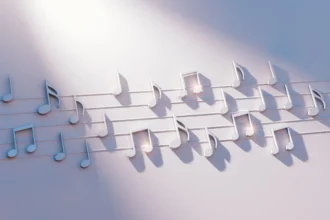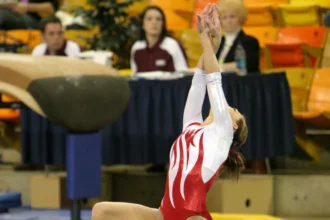In gymnastics, first and last impressions matter. The starting and ending poses in a floor routine frame the performance. They show confidence, control, and connection to the music, making them essential parts of every gymnast’s routine.
What Is a Starting Pose in Gymnastics?
A starting pose is the first still position a gymnast takes after saluting the judges and stepping onto the floor. It officially begins the performance, but here’s a key point: the clock doesn’t start until you begin moving.
This means you can hold the pose for a few seconds to:
- Sync your first movement with the music’s opening beat
- Take a deep breath and calm nerves
- Establish the tone of your routine
A clean, confident starting pose instantly tells the judges you’re in control. It shows posture, balance, and style before your first skill even begins.
Scoring Impact
According to the 2025–2028 FIG Code of Points, judges may deduct up to 0.30 if a gymnast wobbles, bends her knees, or shows lack of expression in the starting pose. Holding a steady shape for at least one second is the simplest way to show control and avoid deductions.
Popular Starting Pose Ideas
- High-Relevé Lunge with Arms in High Fifth – Ballet-inspired with long, clean lines. Perfect for elegant or lyrical music.
- C-Curve on One Knee – Rounded back, fingers reaching toward the floor. Suited for emotional or contemporary pieces.
- Prone “Superwoman” Hold – Lying flat with arms stretched forward as if flying. Bold and playful for upbeat or hip-hop tracks.
What Is an Ending Pose in Gymnastics?
An ending pose is the final still position held at the end of a routine, almost always matched to the last beat of the music. It signals completion to both the judges and the audience.
You should hold the pose for about one second before saluting or walking off to demonstrate stability and confidence.
Scoring Impact
Execution deductions of 0.10–0.30 can be taken if the gymnast wobbles, steps, or adds extra movements after the ending pose. Finishing outside the boundary or exceeding the time limit can also result in neutral deductions.
Note: While USAG Xcel does not require a formal salute at the end, many gymnasts still salute as a sign of professionalism.
Popular Ending Pose Ideas
- Forced-Arch Lunge – Deep lunge with extended arms, showing control and strength.
- Arabesque or Scale Balance – Elegant one-leg balances that highlight flexibility and artistry.
- Kneeling Pose – Theatrical and emotional, fitting for lyrical routines.
- Power Stance with Salute – Bold and confident, famously used by Simone Biles.
- Floor-Based Split or Leaning Pose – Dramatic, stylish, and perfect for music that fades softly.
How to Choose an Effective Starting Pose
A great starting pose should reflect confidence, fit your music, and flow naturally into your first move.
- Match the music:
- Soft/lyrical → low poses (kneels, floor reaches)
- Powerful/upbeat → bold stances, extended arms
- Jazz/Latin → head turns, hip accents, or playful gestures
- Flow into the first skill: If opening with a leap, turn, or tumbling pass, choose a shape that transitions smoothly.
- Show off strengths: Use your pose to highlight long lines, flexibility, or arm expression.
- Face the judges: Angle your body so your artistry is visible.
- Stay grounded if nervous: Low shapes like kneels help with balance and calm before starting.
- Keep it level-appropriate:
- Levels 1–3 → clean, simple shapes (lunges, T-positions)
- Optional/Xcel → more creative or floor-based poses
How to Design a Memorable Ending Pose
Your last pose is the final image the judges see, make it unforgettable.
- Match the music’s final note:
- Sharp ending → bold, high-energy stance
- Soft ending → smooth, graceful finish
- Flow from the last skill: Land your final tumbling pass and transition naturally into the pose.
- Match the mood: Keep consistency with the routine’s style (sassy, powerful, or lyrical).
- End with confidence: Head high, eyes lifted, and facial expression fully engaged.
What to Avoid
- Rushing or fidgeting after hitting your pose
- Saluting before completing the final shape
- Choosing poses that are too difficult to hold under pressure
In conclusion, starting and ending poses frame your routine. While they aren’t scored separately, they influence artistry, presentation, and overall impression, which contribute to execution marks.






